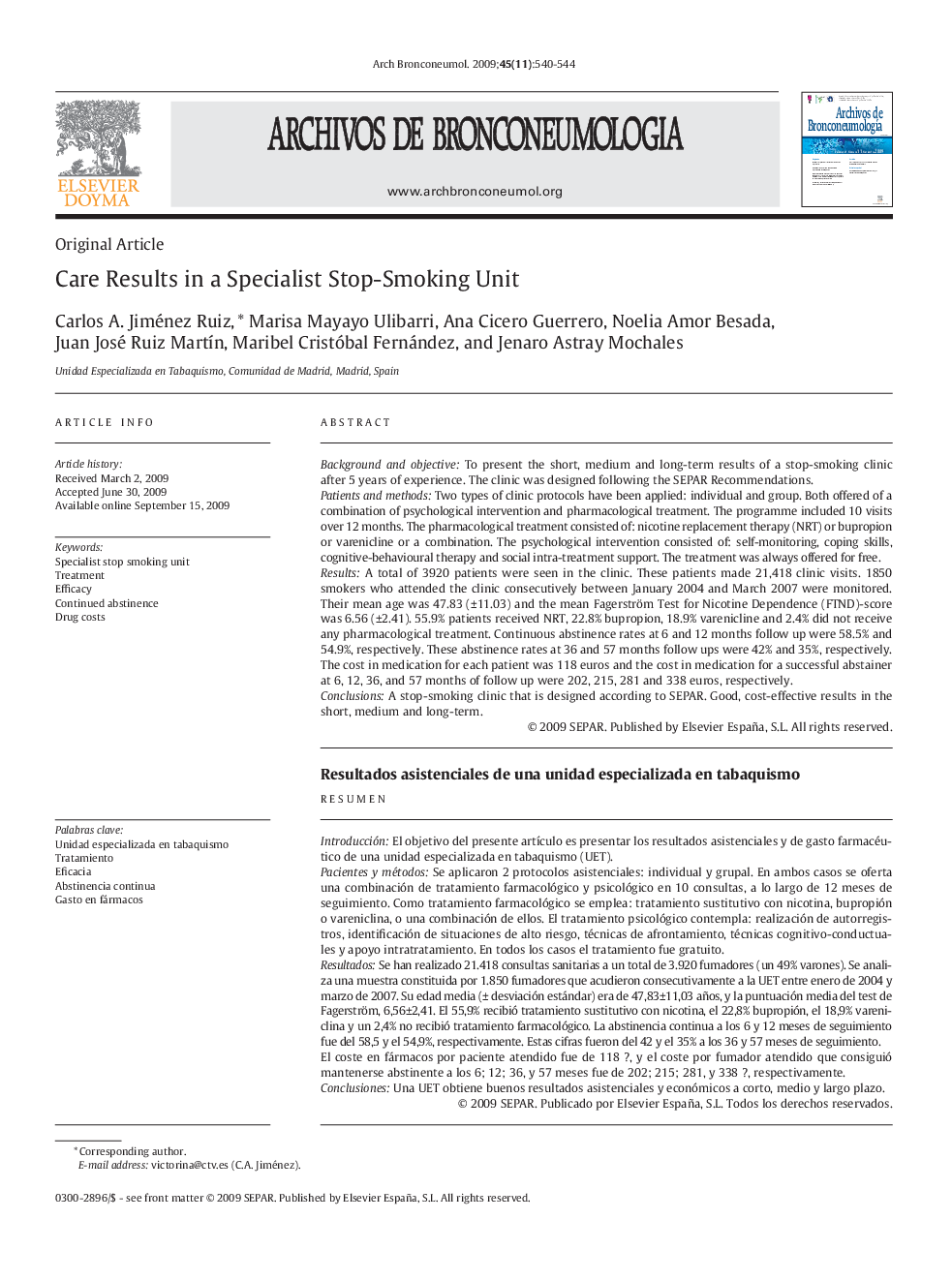| Article ID | Journal | Published Year | Pages | File Type |
|---|---|---|---|---|
| 4206633 | Archivos de Bronconeumología (English Edition) | 2009 | 5 Pages |
Background and objectiveTo present the short, medium and long-term results of a stop-smoking clinic after 5 years of experience. The clinic was designed following the SEPAR Recommendations.Patients and methodsTwo types of clinic protocols have been applied: individual and group. Both offered of a combination of psychological intervention and pharmacological treatment. The programme included 10 visits over 12 months. The pharmacological treatment consisted of: nicotine replacement therapy (NRT) or bupropion or varenicline or a combination. The psychological intervention consisted of: self-monitoring, coping skills, cognitive-behavioural therapy and social intra-treatment support. The treatment was always offered for free.ResultsA total of 3920 patients were seen in the clinic. These patients made 21,418 clinic visits. 1850 smokers who attended the clinic consecutively between January 2004 and March 2007 were monitored. Their mean age was 47.83 (±11.03) and the mean Fagerström Test for Nicotine Dependence (FTND)-score was 6.56 (±2.41). 55.9% patients received NRT, 22.8% bupropion, 18.9% varenicline and 2.4% did not receive any pharmacological treatment. Continuous abstinence rates at 6 and 12 months follow up were 58.5% and 54.9%, respectively. These abstinence rates at 36 and 57 months follow ups were 42% and 35%, respectively. The cost in medication for each patient was 118 euros and the cost in medication for a successful abstainer at 6, 12, 36, and 57 months of follow up were 202, 215, 281 and 338 euros, respectively.ConclusionsA stop-smoking clinic that is designed according to SEPAR. Good, cost-effective results in the short, medium and long-term.
ResumenIntroducciónEl objetivo del presente artículo es presentar los resultados asistenciales y de gasto farmacéutico de una unidad especializada en tabaquismo (UET).Pacientes y métodosSe aplicaron 2 protocolos asistenciales: individual y grupal. En ambos casos se oferta una combinación de tratamiento farmacológico y psicológico en 10 consultas, a lo largo de 12 meses de seguimiento. Como tratamiento farmacológico se emplea: tratamiento sustitutivo con nicotina, bupropión o vareniclina, o una combinación de ellos. El tratamiento psicológico contempla: realización de autorregistros, identificación de situaciones de alto riesgo, técnicas de afrontamiento, técnicas cognitivo-conductuales y apoyo intratratamiento. En todos los casos el tratamiento fue gratuito.ResultadosSe han realizado 21.418 consultas sanitarias a un total de 3.920 fumadores (un 49% varones). Se analiza una muestra constituida por 1.850 fumadores que acudieron consecutivamente a la UET entre enero de 2004 y marzo de 2007. Su edad media (± desviación estándar) era de 47,83±11,03 años, y la puntuación media del test de Fagerström, 6,56±2,41. El 55,9% recibió tratamiento sustitutivo con nicotina, el 22,8% bupropión, el 18,9% vareniclina y un 2,4% no recibió tratamiento farmacológico. La abstinencia continua a los 6 y 12 meses de seguimiento fue del 58,5 y el 54,9%, respectivamente. Estas cifras fueron del 42 y el 35% a los 36 y 57 meses de seguimiento. El coste en fármacos por paciente atendido fue de 118 ?, y el coste por fumador atendido que consiguió mantenerse abstinente a los 6; 12; 36, y 57 meses fue de 202; 215; 281, y 338 ?, respectivamente.ConclusionesUna UET obtiene buenos resultados asistenciales y económicos a corto, medio y largo plazo.
